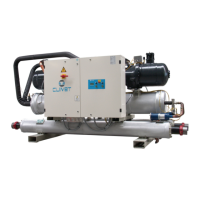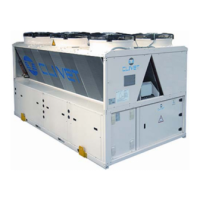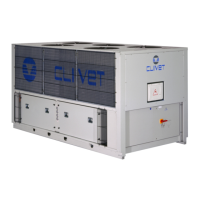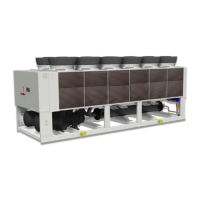Do you have a question about the CLIVET WDH-3 2.360 and is the answer not in the manual?
Provides unique identification for tracing features and components; essential for spare parts.
Unit must be installed/tested by expert personnel meeting legal requirements.
Unit is designed for cooling/heating water for air-conditioning. Any other use is not covered.
Highlights areas where only authorized personnel may operate, defining internal/external zones.
Risks from incorrect installation (leaks, shocks, fire) and necessity of qualified technicians.
Covers fire, burns, mechanical contact, panel security, and electrical system hazards.
Risks from refrigerant escaping (toxic effects) and contact with heat sources.
Safe handling operations respecting safety norms, valuing critical points, and verifying lifting capacity.
Measures to prevent frost formation when unit is subject to near 0°C temperatures.
Illustrates recommended connections for the user side, including optional components.
Importance of water purity for exchanger efficiency and preventing damage; filter installation and mesh size.
Use of antifreeze solutions like ethylene glycol for units operating near 0°C or with geothermal probes.
Provides detailed electrical data (current, power, inrush current) for different sizes and acoustic configurations.
Step-by-step procedure for connecting the unit to the main power supply, including safety checks.
Essential pre-start checks including installation, power supply, and refrigerant/water systems.
Checks for system washing, filling, pressurization, shut-off valves, air presence, and antifreeze percentage.
Verification of screw tightening, grounding, panel/device repositioning, and voltage/phase balance.
How to visualize active alarms and navigate the alarm menu.
Lists common causes for high pressure alarms in cooling operation.
Lists common causes for low pressure alarms in cooling operation.
Troubleshooting steps for faulty probes, including checks and module replacement.
Troubleshooting steps for faulty pressure transducers, including checks and part replacement.
Identifies causes for compressor protection activation, like winding issues or discharge temperature.
Provides unique identification for tracing features and components; essential for spare parts.
Unit must be installed/tested by expert personnel meeting legal requirements.
Unit is designed for cooling/heating water for air-conditioning. Any other use is not covered.
Highlights areas where only authorized personnel may operate, defining internal/external zones.
Risks from incorrect installation (leaks, shocks, fire) and necessity of qualified technicians.
Covers fire, burns, mechanical contact, panel security, and electrical system hazards.
Risks from refrigerant escaping (toxic effects) and contact with heat sources.
Safe handling operations respecting safety norms, valuing critical points, and verifying lifting capacity.
Measures to prevent frost formation when unit is subject to near 0°C temperatures.
Illustrates recommended connections for the user side, including optional components.
Importance of water purity for exchanger efficiency and preventing damage; filter installation and mesh size.
Use of antifreeze solutions like ethylene glycol for units operating near 0°C or with geothermal probes.
Provides detailed electrical data (current, power, inrush current) for different sizes and acoustic configurations.
Step-by-step procedure for connecting the unit to the main power supply, including safety checks.
Essential pre-start checks including installation, power supply, and refrigerant/water systems.
Checks for system washing, filling, pressurization, shut-off valves, air presence, and antifreeze percentage.
Verification of screw tightening, grounding, panel/device repositioning, and voltage/phase balance.
How to visualize active alarms and navigate the alarm menu.
Lists common causes for high pressure alarms in cooling operation.
Lists common causes for low pressure alarms in cooling operation.
Troubleshooting steps for faulty probes, including checks and module replacement.
Troubleshooting steps for faulty pressure transducers, including checks and part replacement.
Identifies causes for compressor protection activation, like winding issues or discharge temperature.











